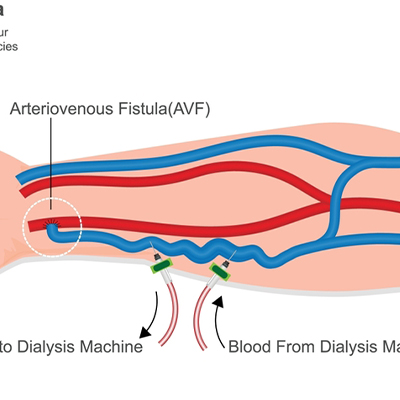Av Fistula surgery in Anantapur
An arteriovenous (AV) fistula is an abnormal connection formed between an artery and a vein. Typically, blood circulates from the arteries through small blood vessels known as capillaries before returning to the veins. In this process, nutrients and oxygen are delivered from the capillaries to the body's tissues. In the case of an arteriovenous fistula, blood bypasses some capillaries and flows directly from an artery into a vein. This diversion results in reduced blood supply to the tissues located downstream of the capillaries that are bypassed.
Av Fistula surgery in Anantapur are essential for patients undergoing dialysis treatment. A nurse initiates the dialysis process by inserting two needles into the AV fistula. One needle extracts blood, which is then sent to the dialysis machine for filtration, while the second needle facilitates the safe return of the filtered blood back into the body.

Occurrence
Arteriovenous fistulas at Best Hospital for AV Fistula in Anantapur predominantly form in the legs, although they can arise in various locations throughout the body. In individuals with advanced kidney disease, a surgical procedure may be performed to create an arteriovenous fistula for dialysis purposes.
The symptoms associated with arteriovenous fistulas as per Best AV fistula doctor in Anantapur vary based on their anatomical location. If left untreated, a significant arteriovenous fistula can result in severe complications. Management options for arteriovenous fistulas encompass observation, compression therapy, catheter-based interventions, and, in certain cases, surgical intervention.
Symptoms
Small arteriovenous fistulas located in the legs, arms, lungs, kidneys, or brain typically do not present any noticeable signs or symptoms. Generally, these small fistulas require no treatment beyond regular monitoring by a healthcare professional. In contrast, larger arteriovenous fistulas may manifest various signs and symptoms.
The signs and symptoms associated with arteriovenous fistulas needing intervention from Arteriovenous Fistula Surgeon in Anantapur may include
- Prominent, purplish veins visible through the skin, resembling varicose veins
- Swelling in the limbs
- Reduced blood pressure
- General fatigue
- Heart failure
A significant arteriovenous fistula in the lungs, known as a pulmonary arteriovenous fistula, poses a serious health risk and may lead to
- Cyanosis, indicated by pale gray or blue lips or fingernails due to insufficient blood flow
- Clubbing, characterized by the fingertips becoming wider and rounder than usual
- Hemoptysis, or coughing up blood
Additionally, an arteriovenous fistula within the digestive tract can result in gastrointestinal bleeding. If you exhibit signs and symptoms indicative of an arteriovenous fistula, it is advisable to schedule an appointment with your healthcare provider, Dr. M. Surendra Babu. Timely identification of an arteriovenous fistula can facilitate more effective treatment and may also diminish the likelihood of complications such as blood clots or heart failure.
